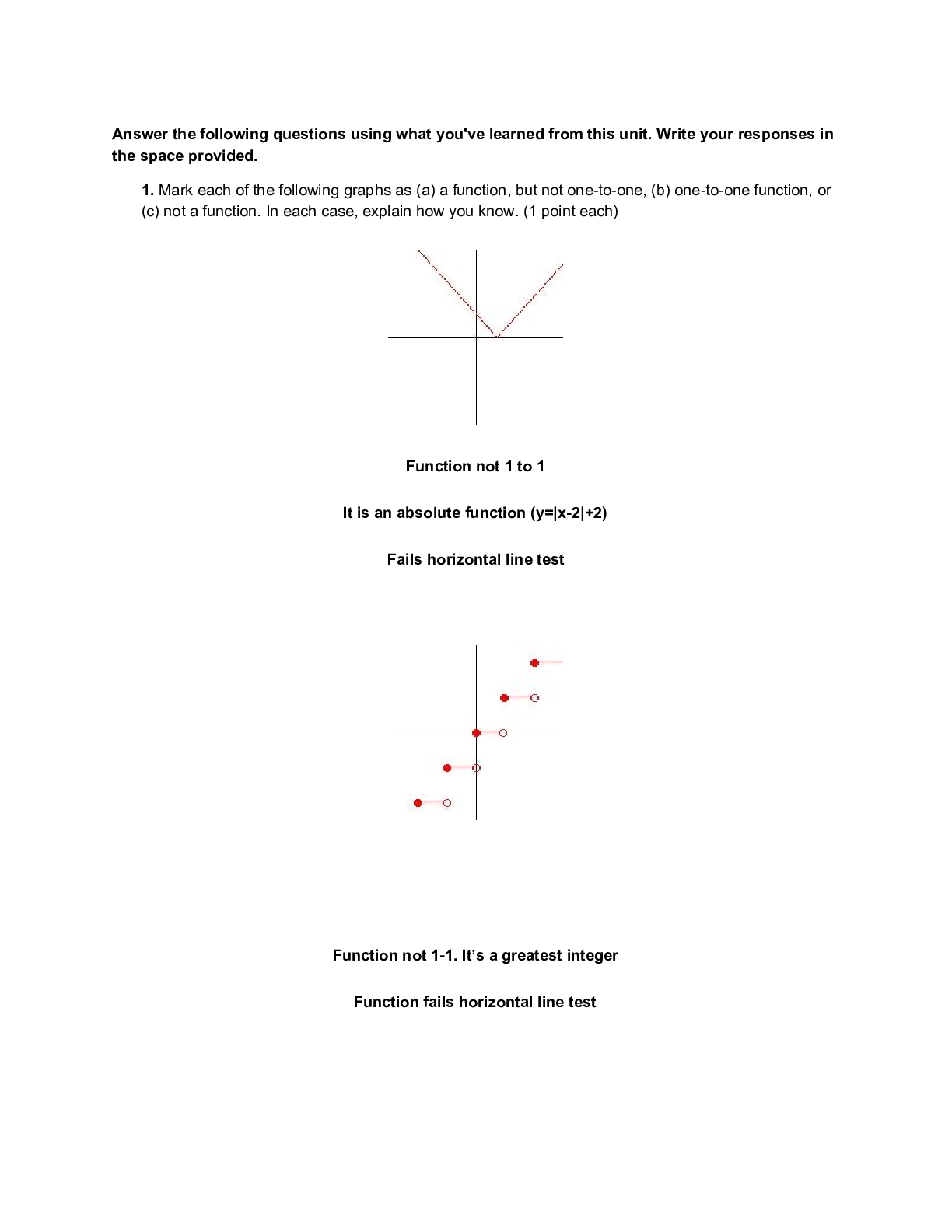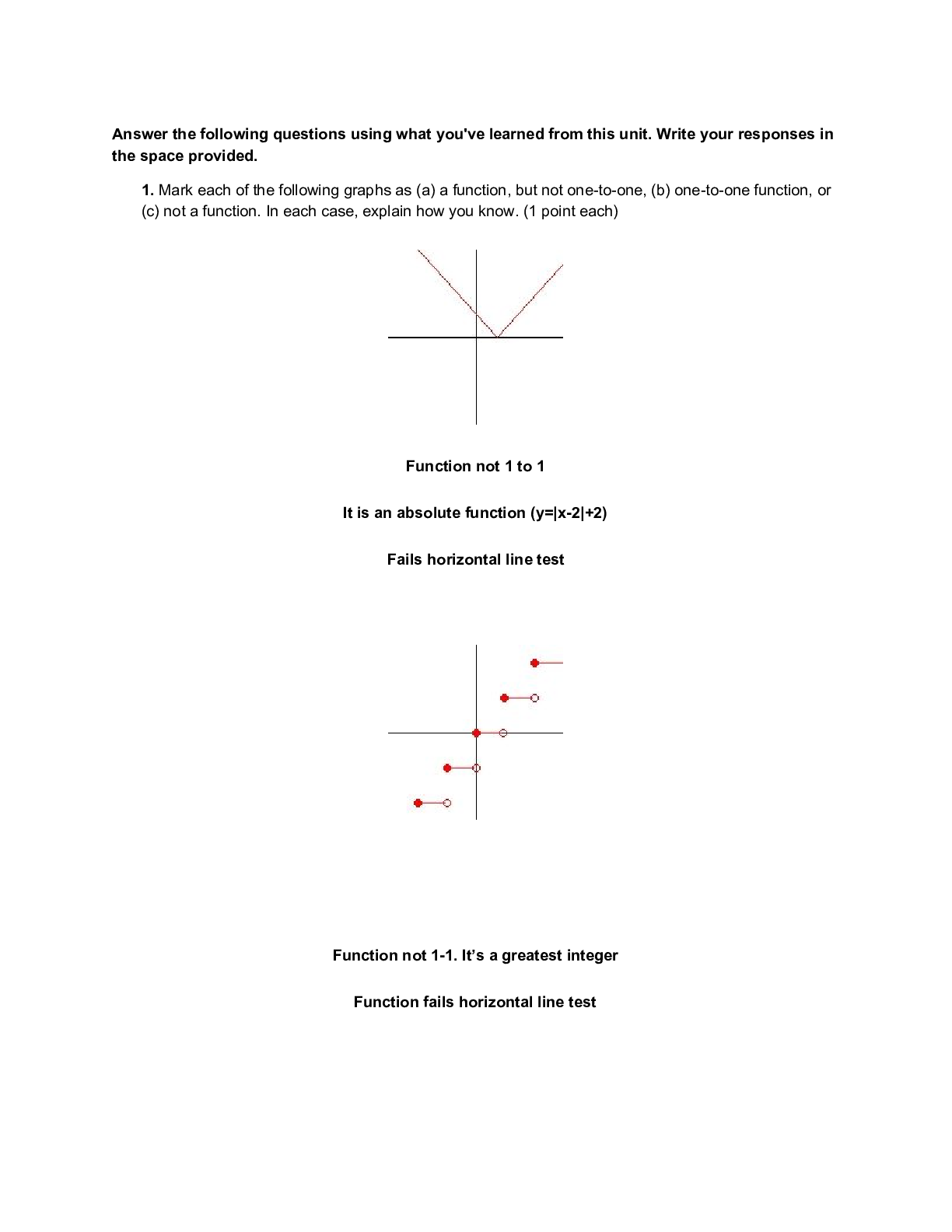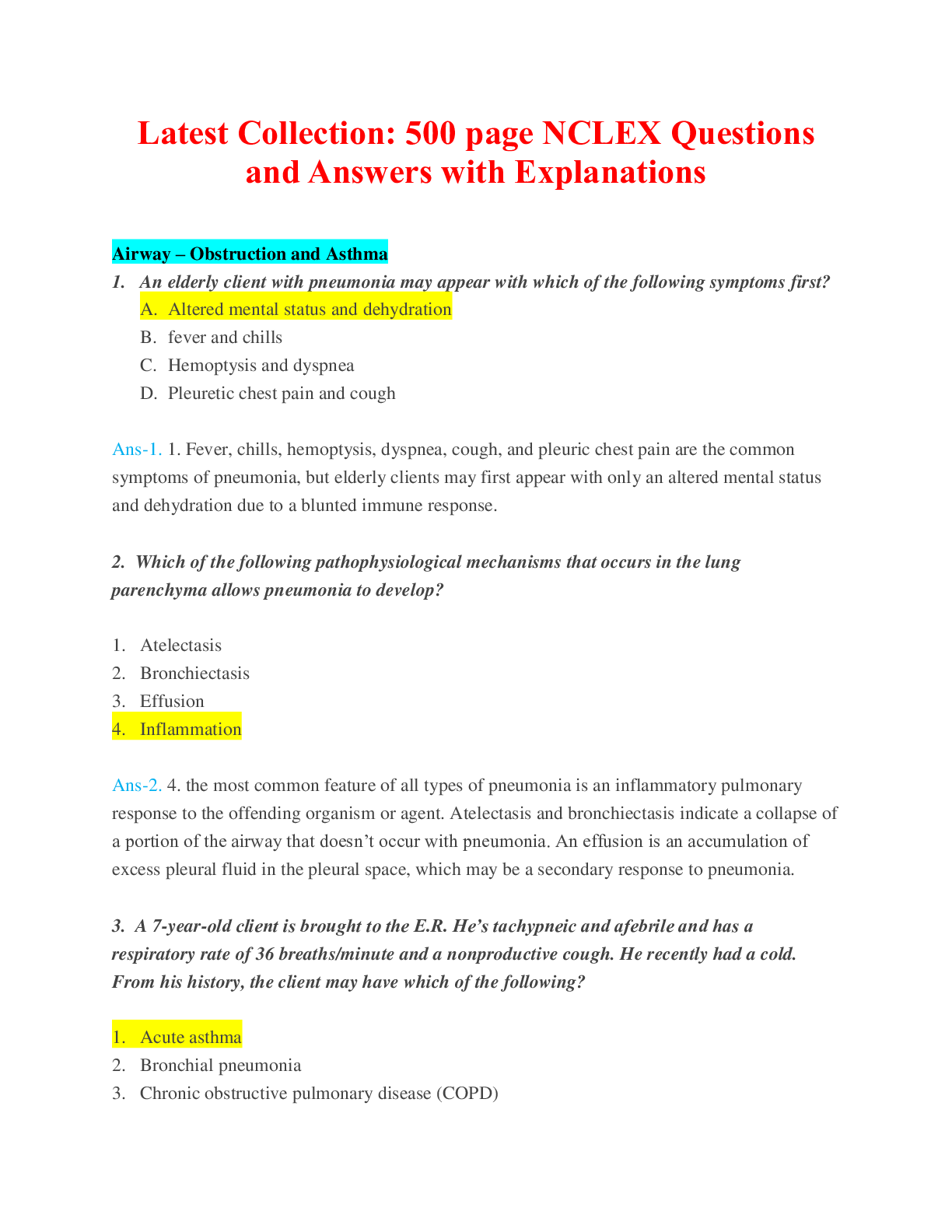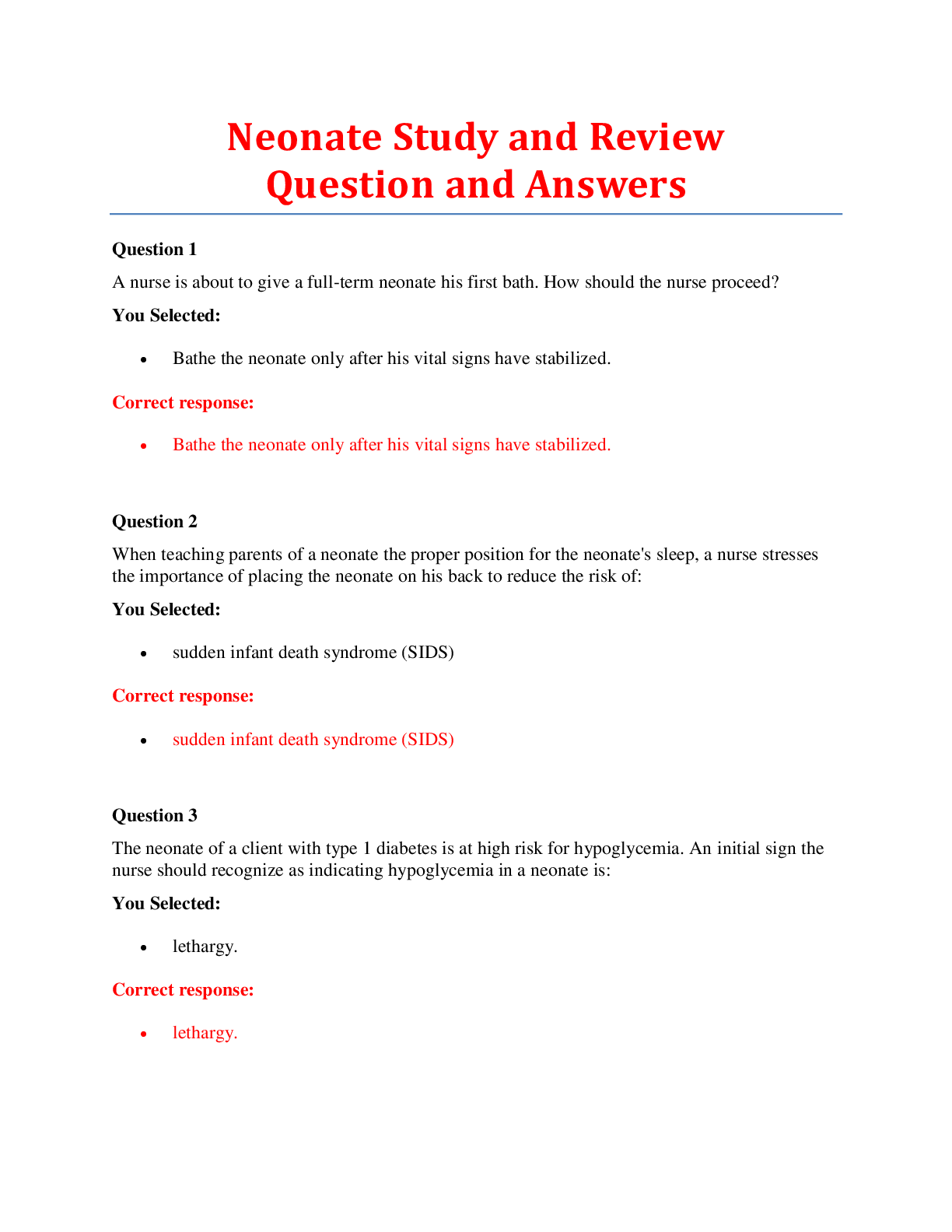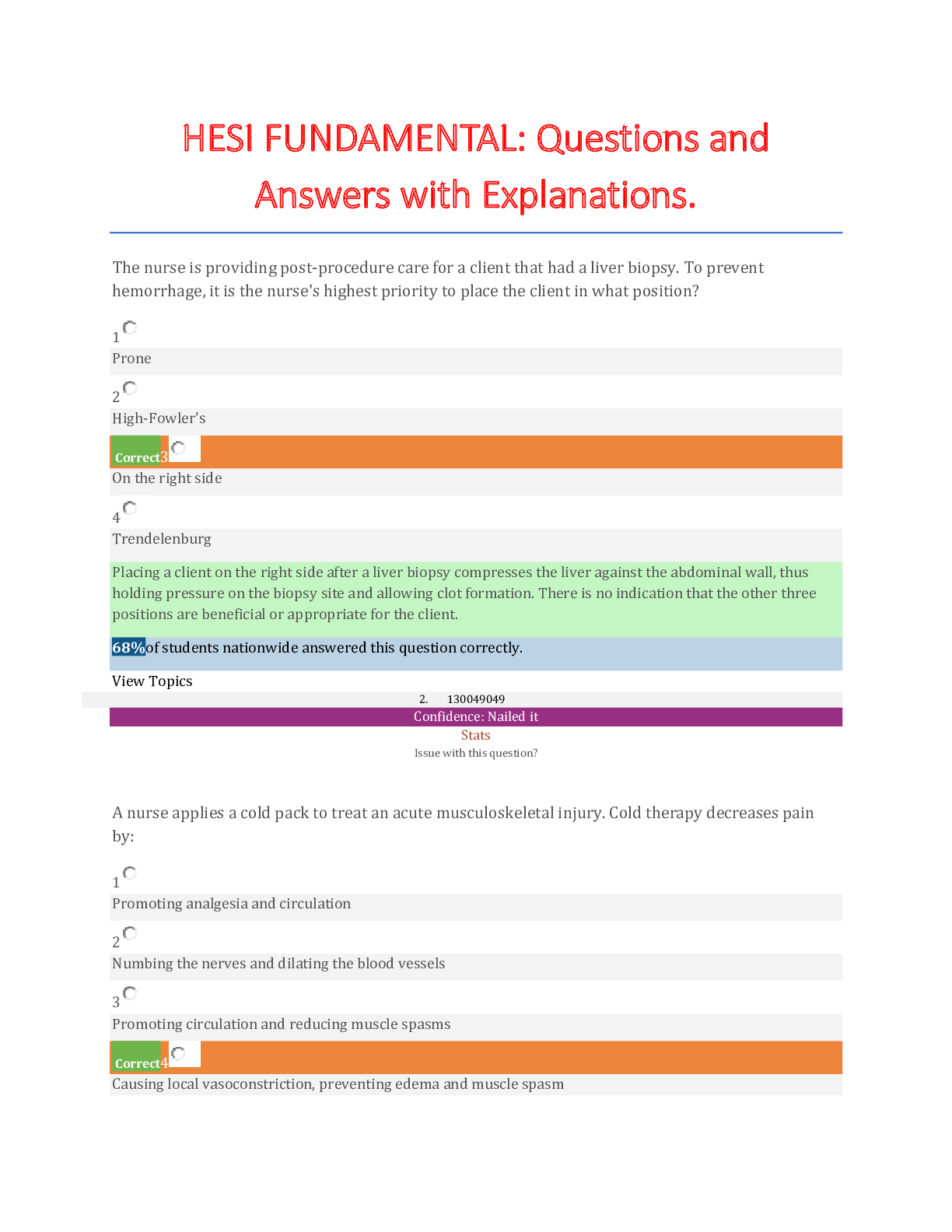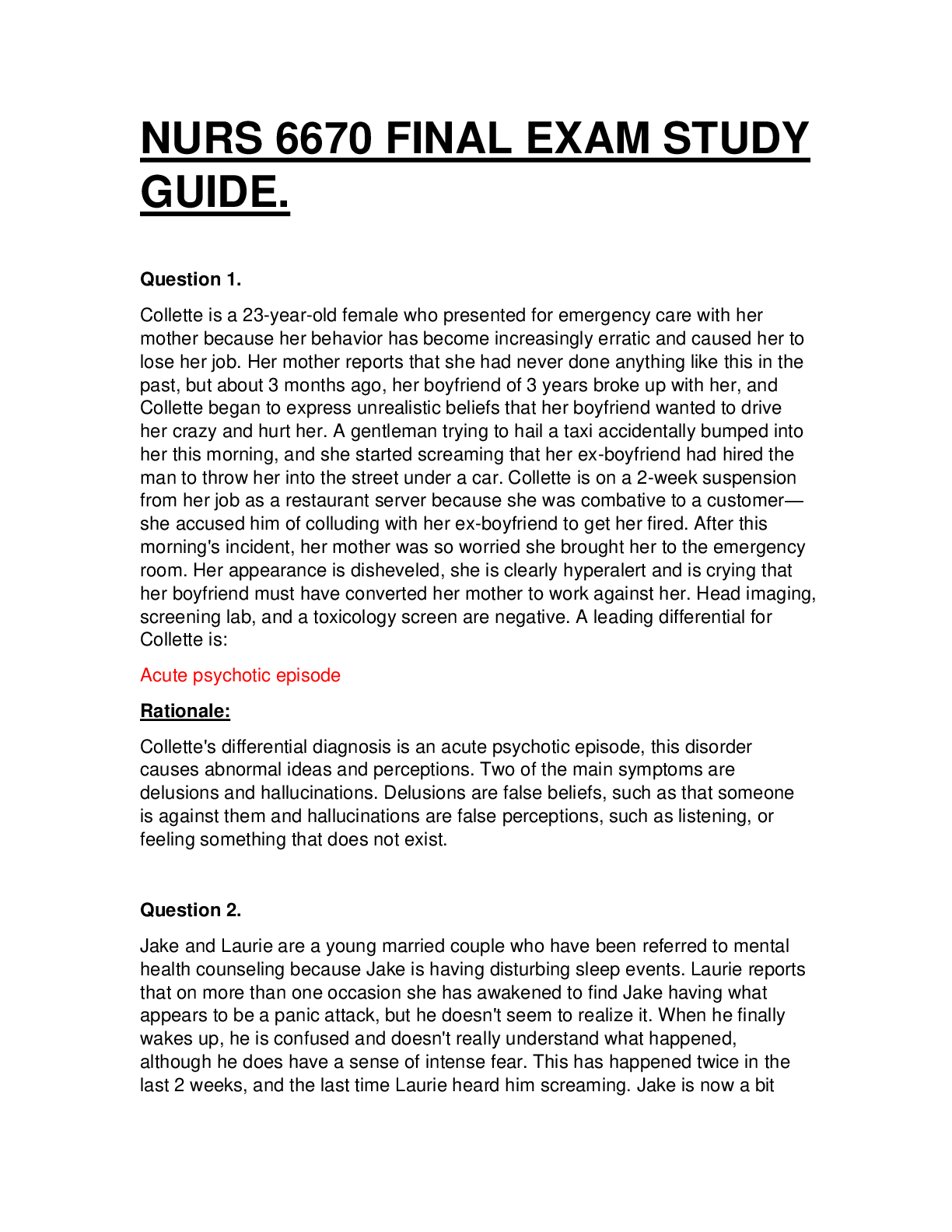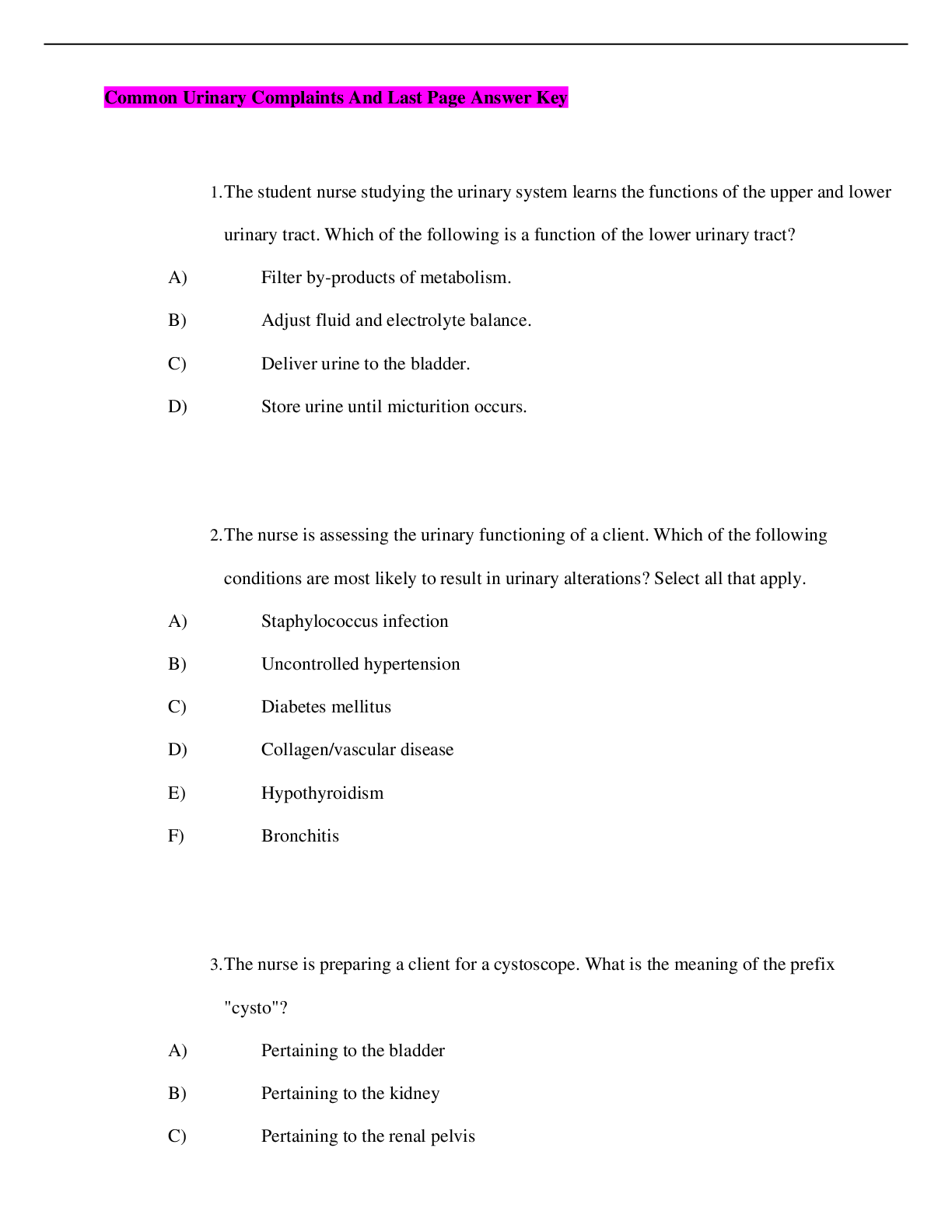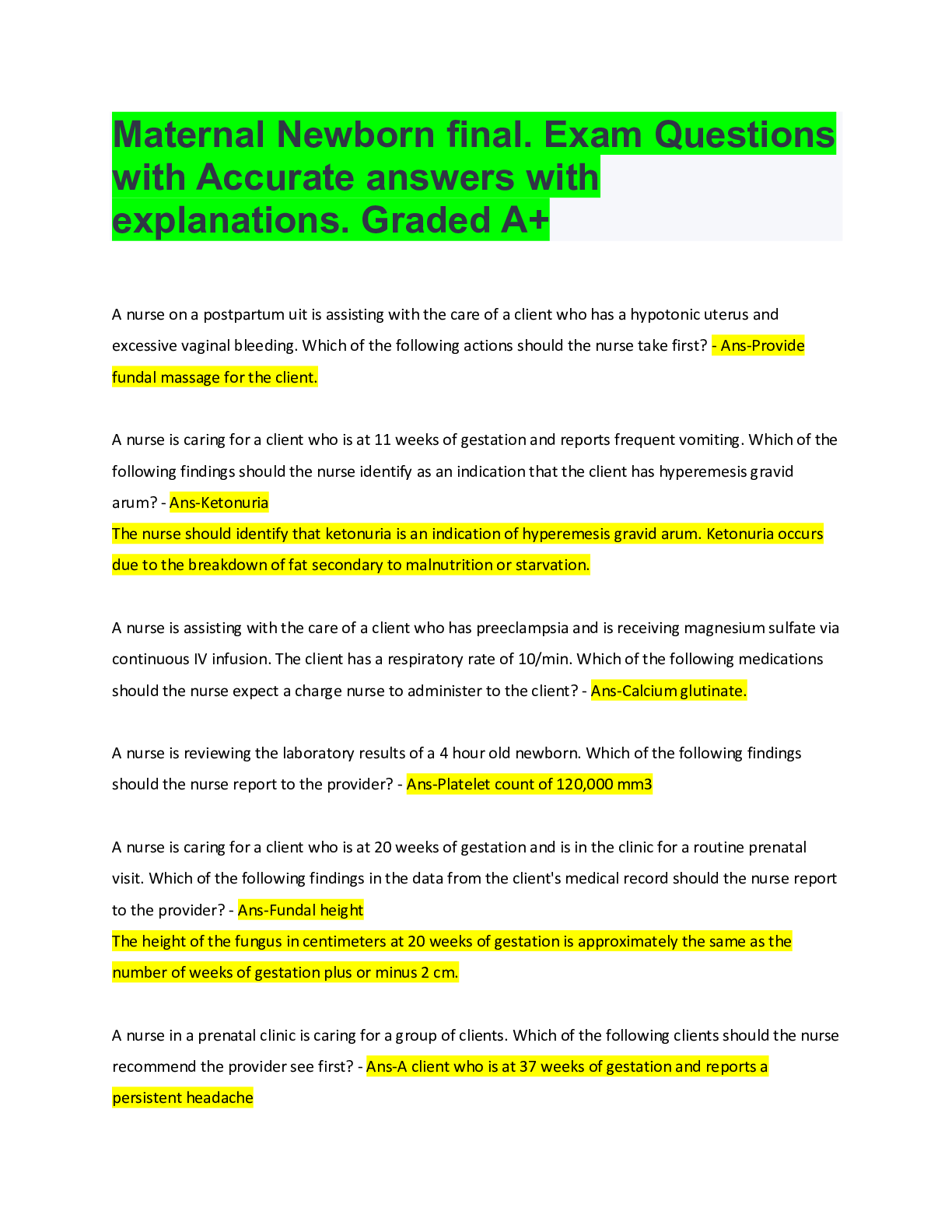*NURSING > QUESTIONS & ANSWERS > NURSING NOTES: Reproduction Question and Answers With Explanations. Best Review Exam. (All)
NURSING NOTES: Reproduction Question and Answers With Explanations. Best Review Exam.
Document Content and Description Below
Reproduction Question and Answers: Revision Exam Question 1 A nurse is caring for a client whose membranes ruptured prematurely 12 hours ago. When assessing this client, the nurse's highest prior... ity is to evaluate: Question 2 A 31-year-old multigravid client at 39 weeks' gestation admitted to the hospital in active labor is receiving intravenous lactated Ringer's solution and a continuous epidural anesthetic. During the first hour after administration of the anesthetic, the nurse should monitor the client for: Question 3 A 23-year-old client diagnosed with schizophrenia cheerfully announces, "My mom and I are so excited that I am pregnant. She is willing to help us take care of the baby too." Which reason should cause the nurse to be concerned about this situation? Question 4 Which of the following is a priority nursing diagnosis for the client presenting with pelvic inflammatory disease? Question 5 A couple has completed testing and is a candidate for in vitro fertilization. The nurse is reviewing the procedure with them and realizes that further instruction is needed when the woman states: Question 6 The nurse is teaching a 17-year-old girl who has a severe gonorrheal infection. The nurse realizes that the girl understands the implications of her disease when she tells the nurse: Question 7 After the nurse instructs a client who is scheduled for in vitro fertilization (IVF) about the procedure, which statement by the client indicates to the nurse that the instructions have been successful? Question 8 A multigravid client at 34 weeks’ gestation who is leaking amniotic fluid has just been hospitalized with a diagnosis of preterm premature rupture of membranes and preterm labor. The client’s contractions are 20 minutes apart, lasting 20 to 30 seconds. Her cervix is dilated to 2 cm. The nurse reviews prescriptions (see chart). Which prescription should the nurse initiate first? Question 9 The nurse is assessing a client who is 4 hours postpartum. Based on the findings documented by the nurse, which action is most appropriate at this time? Question 10 Which client would benefit most from information explaining the importance of receiving an annual Papanicolaou (PAP) test? Question 1 The nurse is caring for a client on her second postpartum day. The nurse should expect the client's lochia to be: Question 2 A couple is inquiring about vasectomy as a permanent method of contraception. Which teaching statement would the nurse include in the teaching plan? Question 3 A 20-year-old married client with a positive pregnancy test states, “Is it really true? I can not believe I am going to have a baby!” Which response by the nurse would be most appropriate at this time? Question 4 On a client's second postpartum visit, a physician reviews the chart. What's the best term for the lochia described? Question 5 A labor and birth nurse is caring for a client in labor. Which of the following does the nurse identify as a sign that the second stage of labor has begun? Question 6 A primigravida client is admitted to the labor and birth area where the nurse evaluates her. Which of the following assessment findings would be a priority for the nurse to report to the healthcare provider? Question 7 A client in active labor asks the nurse why her blood pressure is being monitored so frequently. Which of the following is an appropriate response by the nurse? Question 8 The nurse brings the infant to the new mother after obtaining assessment data and performing newborn interventions. Which of the following behaviors exhibited by the mother demonstrates that effective bonding is beginning to take place? Question 9 During a prenatal visit, a health care provider decides to admit a client to the hospital. Based on the nurse’s progress note, which complication of pregnancy would the health care provider suspect? Question 10 A nurse is caring for a client in the fourth stage of labor. Based on the nurse’s note, which postpartum complication has the client developed? Question 1 A mother brings her 2-month-old infant to the clinic for a well-baby checkup. To best assess the interaction between the mother and infant, the nurse should observe them: Question 2 A nurse is teaching a group of clients about birth control methods. When providing instruction about subdermal contraceptive implants, the nurse should cite which feature as the main advantage of this method? Question 3 The nurse is admitting a primigravid client at 37 weeks' gestation who has been diagnosed with preeclampsia to the labor and birth area. Which client care rooms is most appropriate for this client? Question 4 A primigravida, currently about 8 weeks pregnant, and her husband ask when they should begin the preparation for childbirth classes that discuss maternal nutrition during pregnancy. Which time would be most appropriate for the nurse to suggest that they begin the classes? Question 5 A client is a long-distance runner and is 8 weeks pregnant with her first baby. The client tells the nurse that she would like to continue running throughout the pregnancy and asks the nurse if there are any safety risks. Which response by the nurse correctly identifies musculoskeletal changes in pregnancy that may be a safety risk to the client? Question 6 A client at 24 weeks gestation comes to the clinic for a prenatal check-up and informs the nurse that she has been “seeing double.” The nurse checks the urine and determines that there is 3+ proteinuria. What does the nurse determine is the potential priority problem? Question 7 The nurse is teaching pain management to a prenatal class. The nurse knows that the instruction has been effective when a participant says which of the following? Question 8 A woman who delivered her last infant by caesarean section is admitted to the hospital at term with contractions every 5 minutes. The health care provider (HCP) intends to have her undergo “a trial labor.” The nurse explains to the client that: Question 9 When working the mother-baby unit which client would the nurse anticipate giving Rho(D) immune globulin (human) to: Question 10 The nurse is caring for a female client who states, “I am having my menstrual period every two weeks and it lasts for one week. I am concerned because I want to get pregnant.” How should the nurse respond? Select all that apply. Question 1 The third stage of labor ends: Question 2 A client is 9 days postpartum and breast-feeding her neonate. The client experiences pain, redness, and swelling of her left breast and is diagnosed with mastitis. The nurse teaching the client how to care for her infected breast should include which information? Question 3 The nurse is working with four clients on the obstetrical unit. Which client will be the highest priority for a cesarean section? Question 4 After being examined and fitted for a diaphragm, a 24-year-old client receives instructions about its use. Which client statement indicates a need for further teaching? Question 5 A client who tells the nurse that she would like to use the basal body temperature method for family planning receives instructions about the method. Which client statement indicates to the nurse that the teaching has been successful? Question 6 A 16-year-old primigravida at 36 weeks' gestation who has had no prenatal care experienced a seizure at work and is being transported to the hospital by ambulance. What should the nurse do upon the client’s arrival? Question 7 A laboring client is experiencing increased pain and asks the nurse when she can have an epidural. Which of the following would be a priority intervention by the nurse to establish whether the client can have an epidural? Question 8 The nurse is performing a newborn assessment on a neonate in the childbirth suite. The nurse notes epispadias. Which documentation of the defect would the nurse note Question 9 A pregnant woman at 39 weeks’ gestation comes to the labor and birth suite in early labor. The woman is a member of the local Muslim community. When developing the culturally appropriate plan of care for this client, which aspect would the nurse identify as the priority? Question 10 A nurse completes the initial assessment of a newborn. According to the due date on the antenatal record, the baby is 12 days postmature. Which of the following physical findings contradicts the estimated gestational age of the newborn? Question 1 A postpartum client's husband calls the nurse and says, "My wife feels funny." The nurse enters the room and notes blood gushing from the client's vagina, pallor, and a rapid, thready pulse. What should be the nurse's first intervention? Question 2 The nurse, while shopping in a local department store, hears a multiparous woman say loudly, "I think the baby is coming." After asking someone to call 911, the nurse assists the client to give birth to a term neonate. While waiting for the ambulance, the nurse suggests that the mother initiate breastfeeding, primarily for what reason? Question 3 Before advising a 24-year-old client desiring oral contraceptives for family planning, the nurse would assess the client for which signs and symptoms? Question 4 A 15-year-old primigravid client at approximately 16 weeks’ gestation tells the nurse that she has been experiencing an occasional sharp pain from the fundus to her pubic bone on the left side. The nurse determines that the client is most likely experiencing which complication? Question 5 A multigravid client at 34 weeks’ gestation who is leaking amniotic fluid has just been hospitalized with a diagnosis of preterm premature rupture of membranes and preterm labor. The client’s contractions are 20 minutes apart, lasting 20 to 30 seconds. Her cervix is dilated to 2 cm. The nurse reviews prescriptions (see chart). Which prescription should the nurse initiate first? Question 6 The nurse is caring for a client who is in the transitional stage of labor. The client’s partner is concerned and asks, “What else can I do for my wife? She is so irritable.” Which of the following interventions would the nurse suggest? Select all that apply. Question 7 The nurse is caring for a client in labor who has tested positive for gonorrhea. Which of the following will the nurse include in the client’s plan of care? Question 8 The nurse is performing a vaginal examination on a client in labor.: Question 9 A woman has just given birth to a stillborn baby at 39 weeks gestation. What is the mostappropriate response for the nurse to make at this time? Question 10 The nurse is performing Leopold’s maneuvers to determine fetal presentation and position. Which illustration shows the third maneuver? Question 1 When teaching a group of pregnant adolescents about reproduction and conception, the nurse is correct when stating that fertilization occurs: Question 2 A nulliparous client says that she and her husband plan to use a diaphragm with spermicide to prevent conception. Which should the nurse include as the action of spermicides when teaching the client? Question 3 During a home visit on the fifth postpartum day, the client begins to cry and says that she is worried about her ability to care for her baby adequately. She tells the nurse, “I wish I could just get organized—I need 8 hours of sleep!” The nurse determines that she is experiencing which condition? Question 4 A pregnant client at 26 weeks gestation walks a moderate distance to get to her prenatal class. When she gets to the class, she starts experiencing uterine cramping with no backache or bloody show. She is quite concerned about the cramping and asks the nurse what is happening. The most appropriate response from the nurse would be which of the following? Question 5 The nurse is managing a pregnant client’s second stage of labor. The nurse should intervene when observing which action? Question 6 Which client is the best candidate for a vaginal birth after a caesarean (VBAC)? Question 7 A client who had a hysterectomy 2 hours ago is returning to the postsurgical unit from the recovery room. The nurse is assessing the client. The vital signs are: temperature, 99° F (32° C); pulse, 98 bmp; respirations, 20 breaths/min; BP, 100/65 mm Hg. The urinary catheter is draining freely, and the client wants to try voiding without the catheter. The IV is infusing at 60 gtt/min. The perineal pad is saturated with bright red blood. The nurse reviews the progress notes from the recovery room (see notes). What should the nurse do first? Question 8 A woman who has preeclampsia is receiving magnesium sulfate 20 grams per 500 mL of lactated Ringers via infusion pump. The prescribed rate of infusion is 2 grams/hour. How many mL/hour should the nurse set the infusion pump for? Record your answer using a whole number. Question 9 A client wants to avoid methods of birth control that contain estrogen. Which method would be the nurse recommend? Question 10 A pregnant client late in her first trimester comes to the clinic for a follow-up visit. The woman tells the nurse that she has been having morning sickness, but she "tried using this band on her wrist," and it helped cut down on the number of episodes she was having. The nurse interprets this therapy as an example of: Question 1 During the first 3 months, which hormone is most responsible for maintaining pregnancy? Question 2 At what gestational age should a primigravida expect to start feeling quickening? Question 3 On arrival at the emergency department, a client tells the nurse that she suspects that she may be pregnant but has been having a small amount of bleeding and has severe pain in the lower abdomen. The client's blood pressure is 70/50 mm Hg, and her pulse rate is 120 bpm. The nurse notifies the primary health care provider (HCP) immediately because of the possibility of: Question 4 A nurse is caring for a 1-day postpartum client. The progress note below informs the nurse that the client is in which phase of the postpartum period? Question 5 When preparing the room for admission of a multigravid client at 36 weeks’ gestation diagnosed with severe preeclampsia, which item is most important for the nurse to obtain? Question 6 A client who is 5 cm dilated tells the nurse that she has the urge to push. Which of the following is the appropriate response by the nurse? Question 7 A nurse is preparing to teach a client about fetal growth and development during the first 3 months of pregnancy. The nurse is assembling teaching aids by milestones. In ascending order, (month 1, month 2, month 3, and months 4 to 9), how would the nurse arrange the aids? All options must be used. Question 8 A nurse is caring for a premenopausal client who had precancerous cells found during a routine papanicolaou (Pap) test. At which time during the menstrual cycle would the nurse schedule a cervical biopsy? Question 9 A nurse is caring for a primigravid client at 40 weeks gestation in active labor. Assessments include: cervix 5 cm dilated; 90% effaced; station 0; cephalic presentation, FHR baseline is 135 bpm and decreases to 125 bpm shortly after onset of 5 uterine contractions and returns to baseline before the uterine contraction ends. Based on this assessment what action should the nurse take first? Question 10 A nurse is evaluating a fetal monitoring strip to time the contractions of a client in labor. Identify the beginning of the contraction in the illustration. You Selected: • Your selection and the correct area, market by the green box. Question 1 A nurse is teaching a client how to use a diaphragm. Which statement about using a diaphragm is appropriate? Question 2 A 19-year-old nulligravid client visiting the clinic for a routine examination asks the nurse about cervical mucus changes that occur during the menstrual cycle. Which information would the nurse expect to include in the client's teaching plan? Question 3 During a preparation for parenting class, one of the participants asks the nurse, “How will I know if I am really in labor?” What should the nurse tell the participant about true labor contractions? Question 4 After conducting a presentation to a group of adolescent parents on the topic of adolescent pregnancy, the nurse determines that one of the parents needs further instruction when the parent says that adolescents are at greater risk for which complication? Question 5 The nurse is performing an assessment of a client progressing through labor. Place the following findings in the order in which they occur. All options must be used. Question 6 A primigravid client in early labor with abruptio placentae develops disseminated intravascular coagulation (DIC). Which agent should the nurse expect the health care provider (HCP) to prescribe? Question 7 A couple seeks information about natural family planning. Which of the following should the nurse inform the couple about natural family planning? Select all that apply. Question 8 A client thinks that she is 7 weeks pregnant. The nurse would explain that which assessment would best confirm pregnancy? Question 9 A nurse is caring for a woman G1 P0 at 40 weeks gestation in active labor. Assessments include: cervix 5 cm dilated; 90% effaced; station 0; cephalic presentation; FHR baseline is 135 bpm and decreases to 125 bpm shortly after onset of 5 uterine contractions and returns to baseline before the uterine contraction ends. Based on this assessment, what action should the nurse take first? Question 10 A pregnant African American woman at term comes to the labor and birth unit in early labor. When developing the plan of care for this client, the nurse would most likely expect which persons to be major sources of emotional support for the client? Select all that apply. Question 1 The third stage of labor ends: Question 2 A couple has completed testing and is a candidate for in vitro fertilization. The nurse is reviewing the procedure with them and realizes that further instruction is needed when the woman states: Question 3 A client taking oral contraceptives is placed on a 10-day course of antibiotics for an infection. Which instruction should the nurse include in the teaching plan? Question 4 A client is a long-distance runner and is 8 weeks pregnant with her first baby. The client tells the nurse that she would like to continue running throughout the pregnancy and asks the nurse if there are any safety risks. Which response by the nurse correctly identifies musculoskeletal changes in pregnancy that may be a safety risk to the client? Question 5 A client is in the first stage of labor. She asks the nurse what the best physical position is to promote labor progression and efficient uterine contractions. Which of the following responses by the nurse is most appropriate? Question 6 A client returned to the recovery room after a dilatation and curettage has the postoperative medication prescriptions shown in the medical record. What should the nurse do next? Question 7 The nurse brings the infant to the new mother after obtaining assessment data and performing newborn interventions. Which of the following behaviors exhibited by the mother demonstrates that effective bonding is beginning to take place? Question 8 In caring for a pregnant client with hyperemesis gravidarum, which is the priority nursing intervention? Question 9 A woman who delivered her last infant by caesarean section is admitted to the hospital at term with contractions every 5 minutes. The health care provider (HCP) intends to have her undergo “a trial labor.” The nurse explains to the client that: Question 10 A nurse and an LPN are working in the labor and birth unit. Of the activities that must be done immediately, which should the nurse assign to the LPN? Question 1 A client and her spouse, both 25 years old, are having trouble conceiving. Infertility in this couple is defined as: Question 2 A nurse is teaching a group of clients about birth control methods. When providing instruction about subdermal contraceptive implants, the nurse should cite which feature as the main advantage of this method? Question 3 A 23-year-old client diagnosed with schizophrenia cheerfully announces, "My mom and I are so excited that I am pregnant. She is willing to help us take care of the baby too." Which reason should cause the nurse to be concerned about this situation? Question 4 An anxious young adult is brought to the interviewing room of a crisis shelter, sobbing and saying that she thinks she is pregnant but does not know what to do. Which nursing intervention is most appropriate at this time? Question 5 A client taking oral contraceptives is placed on a 10-day course of antibiotics for an infection. Which instruction should the nurse include in the teaching plan? Question 6 A menopausal woman with an intact uterus is taking a combined estrogen and progesterone replacement medication, conjugated estrogens/medroxyprogesterone acetate 0.625 mg/2.5 mg, for severe hot flashes. Combined hormonal therapy is given because estrogen alone: Question 7 While observing a new mother interact with her first baby, the nurse observes that the client appears hesitant to care for the neonate. Which action would be most important for the nurse to do? Question 8 On a client's second postpartum visit, a physician reviews the chart. What's the best term for the lochia described? Question 9 A 44-year-old client has been experiencing spotting, nausea, vomiting, and fatigue. A positive pregnancy test and an ultrasound confirm a 13 week gestation. The client had three prior miscarriages with no term births. What does the nurse recognize as the greatest risk factor for the client at this time? Question 10 A client is in the first stage of labor. She asks the nurse what the best physical position is to promote labor progression and efficient uterine contractions. Which of the following responses by the nurse is most appropriate? Question 11 The nurse is caring for a client in labor. Which of the following is how the nurse would report the frequency of each contraction? Question 12 The nurse is teaching a G2P1 client about her upcoming labor. Which of the following responses would indicate to the nurse that further teaching is necessary? Question 13 A nurse is assisting in the birthing room. The health care provider prepares to perform a midline episiotomy. On the illustration, identify the area where the health care provider makes the incision. You Selected: • Question 14 The nurse is assessing a client who is 4 hours postpartum. Based on the findings documented by the nurse, which action is most appropriate at this time? Question 15 The nurse is working in the labor and child birth unit when a mother with active herpes simplex virus-Type 2 (HSV-2) appears in active labor. Which adjustment in the plan of care is anticipated? Question 16 The nurse would question the prescription for a fetal scalp electrode on which client? Question 17 A nurse and an LPN are working in the labor and birth unit. Of the activities that must be done immediately, which should the nurse assign to the LPN? Question 18 Which client would benefit most from information explaining the importance of receiving an annual Papanicolaou (PAP) test? Question 19 Which client would benefit most from information explaining the importance of receiving an annual Papanicolaou (PAP) test? Question 20 The nurse is caring for a female client who states, “I am having my menstrual period every two weeks and it lasts for one week. I am concerned because I want to get pregnant.” How should the nurse respond? Select all that apply. Question 1 A client is 9 days postpartum and breast-feeding her neonate. The client experiences pain, redness, and swelling of her left breast and is diagnosed with mastitis. The nurse teaching the client how to care for her infected breast should include which information? Question 2 The health care provider (HCP) has determined that a preterm labor client at 34 weeks' gestation has no fetal fibronectin present. Based on this finding, the nurse would anticipate that within the next week: Question 3 A client has obtained levonorgestrel as emergency contraception. After unprotected intercourse, the client calls the clinic to ask questions about taking the contraceptives. The nurse realizes the client needs further explanation when she makes which statement? Question 4 A couple is inquiring about vasectomy as a permanent method of contraception. Which teaching statement would the nurse include in the teaching plan? Question 5 A 39-year-old multigravid client asks the nurse for information about female sterilization with a tubal ligation. Which client statement indicates effective teaching? Question 6 A nulliparous client says that she and her husband plan to use a diaphragm with spermicide to prevent conception. Which should the nurse include as the action of spermicides when teaching the client? Question 7 The nurse is performing a health history for a woman in her first trimester of pregnancy who lives alone with two cats. What education should the nurse provide so that the client may protect herself from illness? Question 8 A parent brings her 2-month-old infant to the clinic for a well-baby checkup. To assess the interaction between parent and infant, in which of the following settings should the nurse should observe the parent and infant? Question 9 During a prenatal visit, a health care provider decides to admit a client to the hospital. Based on the nurse’s progress note, which complication of pregnancy would the health care provider suspect? Question 10 The nurse determines that teaching about the warning signs of preterm labor has been successful when the client states that she will call the health care provider if she has which symptom? Question 1 A mother brings her 2-month-old infant to the clinic for a well-baby checkup. To best assess the interaction between the mother and infant, the nurse should observe them: Question 2 A client has expressed her desire to give birth with minimal intervention. She is now moving into the active phase of labor. What intervention by the nurse would be the priority of care? Question 3 A 31-year-old multigravid client at 39 weeks' gestation admitted to the hospital in active labor is receiving intravenous lactated Ringer's solution and a continuous epidural anesthetic. During the first hour after administration of the anesthetic, the nurse should monitor the client for: Question 4 The nurse is working with four clients on the obstetrical unit. Which client will be the highest priority for a cesarean section? Question 5 Which of the following is a priority nursing diagnosis for the client presenting with pelvic inflammatory disease? Question 6 The nurse is teaching a young woman about using oxcarbazepine to control seizures. The nurse determines teaching is effective when the client states: Question 7 A multigravid client at 34 weeks’ gestation who is leaking amniotic fluid has just been hospitalized with a diagnosis of preterm premature rupture of membranes and preterm labor. The client’s contractions are 20 minutes apart, lasting 20 to 30 seconds. Her cervix is dilated to 2 cm. The nurse reviews prescriptions (see chart). Which prescription should the nurse initiate first? Question 8 A client comes to the clinic stating that she is pregnant with her first child. After the pregnancy is confirmed, which of the following is the priority intervention by the nurse? Question 9 A woman who has preeclampsia is receiving magnesium sulfate 20 grams per 500 mL of lactated Ringers via infusion pump. The prescribed rate of infusion is 2 grams/hour. How many mL/hour should the nurse set the infusion pump for? Record your answer using a whole number. Question 10 A nurse completes the initial assessment of a newborn. According to the due date on the antenatal record, the baby is 12 days postmature. Which of the following physical findings contradicts the estimated gestational age of the newborn? Question 1 A postpartum client's husband calls the nurse and says, "My wife feels funny." The nurse enters the room and notes blood gushing from the client's vagina, pallor, and a rapid, thready pulse. What should be the nurse's first intervention? Question 2 A client scheduled for a vasectomy asks the nurse how soon after the procedure he can have sexual intercourse without using an alternative birth control method. How should the nurse respond? Question 3 A 15-year-old primigravid client at approximately 16 weeks’ gestation tells the nurse that she has been experiencing an occasional sharp pain from the fundus to her pubic bone on the left side. The nurse determines that the client is most likely experiencing which complication? Question 4 When preparing the room for admission of a multigravid client at 36 weeks’ gestation diagnosed with severe preeclampsia, which item is most important for the nurse to obtain? Question 5 The nurse is caring for a 15-year-old adolescent mother after childbirth. The adolescent lives at home with her parents and has a boyfriend who is also 15 years old. Neither is currently working, and they both have plans for higher education. When addressing the psychosocial issues that may occur after the birth of the child, which of the following would be the most important for the nurse to include in his/her teaching? Question 6 A client thinks that she is 7 weeks pregnant. The nurse would explain that which assessment would best confirm pregnancy? Question 7 A client asks why she feels so much variability in fetal activity each day. The nurse explains that fetal movement is affected by which factors? Select all that apply. Question 8 A primigravid client at 38 weeks’ gestation comes to the labor room because “my water broke.” The health care provider (HCP) asks the nurse to verify spontaneous rupture of membranes using nitrazine paper. The nurse observes that the nitrazine paper turns bright blue. The nurse’s next action should be to: Question 9 The nurse is performing a vaginal examination on a client in labor. The nurse finds the fetal presenting part 1 cm above the ischial spines. The nurse should chart the station as: Question 10 A nurse is caring for a woman G1 P0 at 40 weeks gestation in active labor. Assessments include: cervix 5 cm dilated; 90% effaced; station 0; cephalic presentation; FHR baseline is 135 bpm and decreases to 125 bpm shortly after onset of 5 uterine contractions and returns to baseline before the uterine contraction ends. Based on this assessment, what action should the nurse take first? Question 1 During an annual checkup, a client tells the nurse that she and her partner have decided to start a family. Ideally, when should the nurse plan for childbirth education to begin and end? Question 2 A nurse is providing discharge teaching to a postpartum client. Which instruction is the priority to include in her teaching? Question 3 A primigravid client in a preparation for parenting class asks how much blood is lost during an uncomplicated vaginal birth. The nurse should tell the woman: Remediation: Question 4 A young female client is receiving chemotherapy and mentions to the nurse that she and her husband are using a diaphragm for birth control. Which information is most important for the nurse to discuss? Question 5 The nurse is caring for a client that has been in labor for 6 hours. When does the nurse document that the client has ended the third stage of labor? Question 1 Before advising a 24-year-old client desiring oral contraceptives for family planning, the nurse would assess the client for which signs and symptoms? Question 2 When conducting a health history with a female client with thyrotoxicosis, the nurse should ask about which change in the menstrual cycle? Question 3 A primigravid client in early labor with abruptio placentae develops disseminated intravascular coagulation (DIC). Which agent should the nurse expect the health care provider (HCP) to prescribe? Question 4 A woman with preeclampsia is receiving magnesium sulfate via infusion pump at 1 gram/hour. The nurse’s assessment includes: temperature 36.7° C; pulse 78; respirations 12/minute; B/P 128/82; urinary output 90 mLs in last 4 hours via Foley catheter; patellar-tendon reflex absent; ankle clonus absent; fetal heart rate 120 beats per minute; cervix 4 cm dilated, 80% effaced, station –1. Question 5 A nurse is caring for a premenopausal client who had precancerous cells found during a routine papanicolaou (Pap) test. At which time during the menstrual cycle would the nurse schedule a cervical biopsy? Question 1 When teaching a group of pregnant adolescents about reproduction and conception, the nurse is correct when stating that fertilization occurs: Question 2 After surgery to remove a ruptured fallopian tube, a multigravid client receives discharge instructions about potential complications to report to her physician. Which of the following, if stated by the client as a complication, indicates a need for additional teaching? Question 3 The nurse is teaching a young woman about using oxcarbazepine to control seizures. The nurse determines teaching is effective when the client states: Question 4 The nurse is caring for a client in labor who is worried about having an episiotomy. Which of the following interventions will the nurse include in the client’s plan of care? Select all that apply. Question 5 A nurse is caring for a primigravid client at 40 weeks gestation in active labor. Assessments include: cervix 5 cm dilated; 90% effaced; station 0; cephalic presentation, FHR baseline is 135 bpm and decreases to 125 bpm shortly after onset of 5 uterine contractions and returns to baseline before the uterine contraction ends. Based on this assessment what action should the nurse take first? Question 1 The nurse, while shopping in a local department store, hears a multiparous woman say loudly, "I think the baby is coming." After asking someone to call 911, the nurse assists the client to give birth to a term neonate. While waiting for the ambulance, the nurse suggests that the mother initiate breastfeeding, primarily for what reason? Question 2 The charge nurse is preparing for the day shift on the labor and birth unit. Which would be included in the responsibilities for this position? Select all that apply. Question 3 A 19-year-old nulligravid client visiting the clinic for a routine examination asks the nurse about cervical mucus changes that occur during the menstrual cycle. Which information would the nurse expect to include in the client's teaching plan? Question 4 A nurse observes a deceleration on the fetal heart tracing of a woman in labor. The nurse anticipates that which of the following is causing an early deceleration? Question 5 A nurse is preparing to teach a client about fetal growth and development during the first 3 months of pregnancy. The nurse is assembling teaching aids by milestones. In ascending order, (month 1, month 2, month 3, and months 4 to 9), how would the nurse arrange the aids? All options must be used. Question 1 Which information would the nurse include in the teaching plan for a 32-year-old female client requesting information about using a diaphragm for family planning? Question 2 A client is planning to be treated for infertility with the zygote intrafallopian transfer (ZIFT) method. Which information should the nurse include when teaching the client about this type of treatment method? Question 3 A 15-year-old primigravid client at approximately 16 weeks’ gestation tells the nurse that she has been experiencing an occasional sharp pain from the fundus to her pubic bone on the left side. The nurse determines that the client is most likely experiencing which complication? A primiparous client who is bottle-feeding her neonate at 12 hours after birth asks the nurse, “When will my menstrual cycle return?” Which response by the nurse would be most appropriate? Question 5 On arrival at the emergency department, a client tells the nurse that she suspects that she may be pregnant but has been having a small amount of bleeding and has severe pain in the lower abdomen. The client's blood pressure is 70/50 mm Hg, and her pulse rate is 120 bpm. The nurse notifies the primary health care provider (HCP) immediately because of the possibility of: Question 6 The nurse is caring for a client in labor who has tested positive for gonorrhea. Which of the following will the nurse include in the client’s plan of care? Question 7 A nurse is caring for a client who is anxious to know her baby’s due date. The nurse instructs the client on how to determine the baby’s due date according to Nägele’s rule. The client is correct to state which of the following when discussing the use of the rule. Select all that apply. Question 8 A nurse is monitoring the contractions of a client in the first stage of labor. Order the phases of a uterine contraction from the beginning of contraction to its conclusion. All options must be used. Question 9 ? Question 10 The nurse is working in the labor and child birth unit when a mother with active herpes simplex virus-Type 2 (HSV-2) appears in active labor. Which adjustment in the plan of care is anticipated? Question 1 At what gestational age should a primigravida expect to start feeling quickening? Question 2 A young female client is receiving chemotherapy and mentions to the nurse that she and her husband are using a diaphragm for birth control. Which information is most important for the nurse to discuss? Remediation: Question 3 A nurse is caring for a newborn exposed to drugs while in utero. Which of the following behaviors will the nurse expect the newborn to exhibit? Select all that apply. Question 4 The nurse is caring for four clients in labor. Which client is at most risk for a postpartum hemorrhage? You Selected: • a client who is a gravida 4 para 3 with a history of polyhydramnios with this pregnancy Question 5 A client at 32 weeks of gestation has mild preeclampsia. She is discharged home with instructions to remain in bed rest. She would also be instructed to call her health care provider if she experiences which of the following symptoms? Select all that apply. Question 1 During the first 3 months, which hormone is most responsible for maintaining pregnancy? Question 2 After conducting a presentation to a group of adolescent parents on the topic of adolescent pregnancy, the nurse determines that one of the parents needs further instruction when the parent says that adolescents are at greater risk for which complication? Question 3 A nurse is caring for a client who is in the third stage of labor. Which characteristic behaviors does the nurse anticipate at this stage? Select all that apply. Remediation: Question 1 A postpartum client visits her physician to discuss contraception. After a thorough discussion, the client decides to use hormonal contraceptives. The physician orders ethinyl estradiol-ethynodiol diacetate, one tablet by mouth daily, followed by 7 days without a dose before beginning the next cycle of tablets. Which type of combination hormonal contraceptive is ethinyl estradiol-ethynodiol diacetate? Question 2 A client has obtained levonorgestrel as emergency contraception. After unprotected intercourse, the client calls the clinic to ask questions about taking the contraceptives. The nurse realizes the client needs further explanation when she makes which statement? Question 3 A client taking oral contraceptives is placed on a 10-day course of antibiotics for an infection. Which instruction should the nurse include in the teaching plan? Question 4 A client diagnosed with testicular cancer expresses concerns about fertility. The client and his spouse desire to eventually have a family, and the nurse discusses the option of sperm banking. The nurse should inform the couple that sperm banking would need to be performed: Question 5 A client two days postpartum was given a shot of RhoGAM. At the postpartum home visit, the client asks the nurse why she needed RhoGAM. Which of the following is the most appropriate response by the nurse? Question 6 A client is a gravida 2 para 1 and is currently 12 weeks gestation. She states that she drank beer throughout her last pregnancy. The client asks the nurse if it is okay to have a few drinks during this current pregnancy. Which of the following responses by the nurse would be most appropriate? Question 7 A client at 37 weeks gestation is at a prenatal visit and states that she sometimes feels dizzy when lying directly on her back. Which of the following is the nurse’s best response? Question 8 The nurse is assessing a client who is 4 hours postpartum. Based on the findings documented by the nurse, which action is most appropriate at this time? Question 9 The nurse is performing a newborn assessment on a neonate in the childbirth suite. The nurse notes epispadias. Which documentation of the defect would the nurse note Question 10 At an initial prenatal visit the client tells the nurse that her last menstrual period started on April 14th. Using Naegele’s rule, the nurse determines the woman’s estimated due date is when? Question 1 A nurse visits a client at home on the 10th postpartum day. When assessing the client's uterus, which finding requires further evaluation? Question 2 A 31-year-old multigravid client at 39 weeks' gestation admitted to the hospital in active labor is receiving intravenous lactated Ringer's solution and a continuous epidural anesthetic. During the first hour after administration of the anesthetic, the nurse should monitor the client for: Question 3 The health care provider (HCP) has determined that a preterm labor client at 34 weeks' gestation has no fetal fibronectin present. Based on this finding, the nurse would anticipate that within the next week: Question 4 The nurse is working with four clients on the obstetrical unit. Which client will be the highest priority for a cesarean section? Question 5 A 39-year-old multigravid client asks the nurse for information about female sterilization with a tubal ligation. Which client statement indicates effective teaching? Question 6 A client has stress incontinence. Which data from the client's history contributes to the client's incontinence? Question 7 The nurse is admitting a primigravid client at 37 weeks' gestation who has been diagnosed with preeclampsia to the labor and birth area. Which client care rooms is most appropriate for this client? Question 8 A client in labor is given 25 mg of intravenous (IV) meperidine for labor pain. The nurse should monitor the client for which adverse effects of the drug? Select all that apply. Question 9 The nurse is teaching a G2P1 client about her upcoming labor. Which of the following responses would indicate to the nurse that further teaching is necessary? Question 10 A woman who delivered her last infant by caesarean section is admitted to the hospital at term with contractions every 5 minutes. The health care provider (HCP) intends to have her undergo “a trial labor.” The nurse explains to the client that: Question 1 A client has expressed her desire to give birth with minimal intervention. She is now moving into the active phase of labor. What intervention by the nurse would be the priority of care? Question 2 Normal lochial findings in the first 24 hours after birth include: Question 3 The nurse is caring for a client on her second postpartum day. The nurse should expect the client's lochia to be: Question 4 A couple has completed testing and is a candidate for in vitro fertilization. The nurse is reviewing the procedure with them and realizes that further instruction is needed when the woman states: Question 5 A nulliparous client says that she and her husband plan to use a diaphragm with spermicide to prevent conception. Which should the nurse include as the action of spermicides when teaching the client? Question 6 Four hours after cesarean birth of a neonate weighing 8 lb, 13 oz (4,000 g), the primiparous client asks, “If I get pregnant again, will I need to have a cesarean?” When responding to the client, the nurse should base the response to the client about vaginal birth after cesarean (VBAC) on which standard of practice? Question 7 A primigravida, currently about 8 weeks pregnant, and her husband ask when they should begin the preparation for childbirth classes that discuss maternal nutrition during pregnancy. Which time would be most appropriate for the nurse to suggest that they begin the classes? Question 8 A laboring client is experiencing increased pain and asks the nurse when she can have an epidural. Which of the following would be a priority intervention by the nurse to establish whether the client can have an epidural? Question 9 A client in labor received an epidural for pain management. Before receiving the epidural, the client’s blood pressure was 124/76 mm Hg. Ten minutes after receiving the epidural, the client’s blood pressure is 98/56 mm Hg, and the mother is vomiting. Before calling the health care provider (HCP), the nurse should: Question 10 The nurse is caring for a client who has a history of gastric bypass surgery and is now being seen for her first prenatal visit. Which interventions should be included in the plan of care? Select all that apply. TA Question 1 A postpartum client's husband calls the nurse and says, "My wife feels funny." The nurse enters the room and notes blood gushing from the client's vagina, pallor, and a rapid, thready pulse. What should be the nurse's first intervention? Question 2 A client scheduled for a vasectomy asks the nurse how soon after the procedure he can have sexual intercourse without using an alternative birth control method. How should the nurse respond? Question 3 A young female client is receiving chemotherapy and mentions to the nurse that she and her husband are using a diaphragm for birth control. Which information is most important for the nurse to discuss? Question 4 A 16-year-old primigravida at 36 weeks' gestation who has had no prenatal care experienced a seizure at work and is being transported to the hospital by ambulance. What should the nurse do upon the client’s arrival? Question 5 The antenatal clinic nurse is educating a client with gestational diabetes soon after diagnosis. Evaluation for this client session will include which outcome? Select all that apply. Question 6 A woman’s breasts undergo anatomic and physiologic changes during pregnancy and lactation. Which of the following is true? Question 7 The nurse brings the infant to the new mother after obtaining assessment data and performing newborn interventions. Which of the following behaviors exhibited by the mother demonstrates that effective bonding is beginning to take place? Question 8 The nurse performs a routine prenatal assessment on a woman at 35 weeks gestation and finds vital signs: blood pressure 138/88 mm Hg, pulse 82/min, respirations 18/min, temperature 99.1° F (37.3°C). Which statement is most appropriate for the nurse to make at this time? Question 9 A woman is diagnosed with complete molar pregnancy. The nurse understands that the woman requires more teaching when she makes which statement? Question 10 A pregnant client late in her first trimester comes to the clinic for a follow-up visit. The woman tells the nurse that she has been having morning sickness, but she "tried using this band on her wrist," and it helped cut down on the number of episodes she was having. The nurse interprets this therapy as an example of: Question 1 When teaching a group of pregnant adolescents about reproduction and conception, the nurse is correct when stating that fertilization occurs: Question 2 A client is using the rhythm (calendar-basal body temperature) method of family planning. In this method, the unsafe period for sexual intercourse is indicated by: Question 3 After being examined and fitted for a diaphragm, a 24-year-old client receives instructions about its use. Which client statement indicates a need for further teaching? Question 4 A 28-year-old female client is prescribed danazol for endometriosis. The nurse should instruct the client to report: Question 5 A primigravida experiences spontaneous rupture of the membranes. What should the nurse do? Select all that apply. Question 6 The nurse is caring for a 15-year-old adolescent mother after childbirth. The adolescent lives at home with her parents and has a boyfriend who is also 15 years old. Neither is currently working, and they both have plans for higher education. When addressing the psychosocial issues that may occur after the birth of the child, which of the following would be the most important for the nurse to include in his/her teaching? Question 7 The nurse is preparing a laboring client for internal electronic fetal monitoring (EFM). Which finding requires nursing intervention? Question 8 A 17-year-old client confides in the school nurse that he/she is interested in understanding safe sex practices. In instructing the client on how to correctly use a condom, which information would be stressed? Select all that apply. Question 9 The nurse is performing a vaginal examination on a client in labor. The nurse finds the fetal presenting part 1 cm above the ischial spines. The nurse should chart the station as: Question 10 When working the mother-baby unit which client would the nurse anticipate giving Rho(D) immune globulin (human) to: KE A PRACTICE [Show More]
Last updated: 1 year ago
Preview 1 out of 86 pages
Instant download
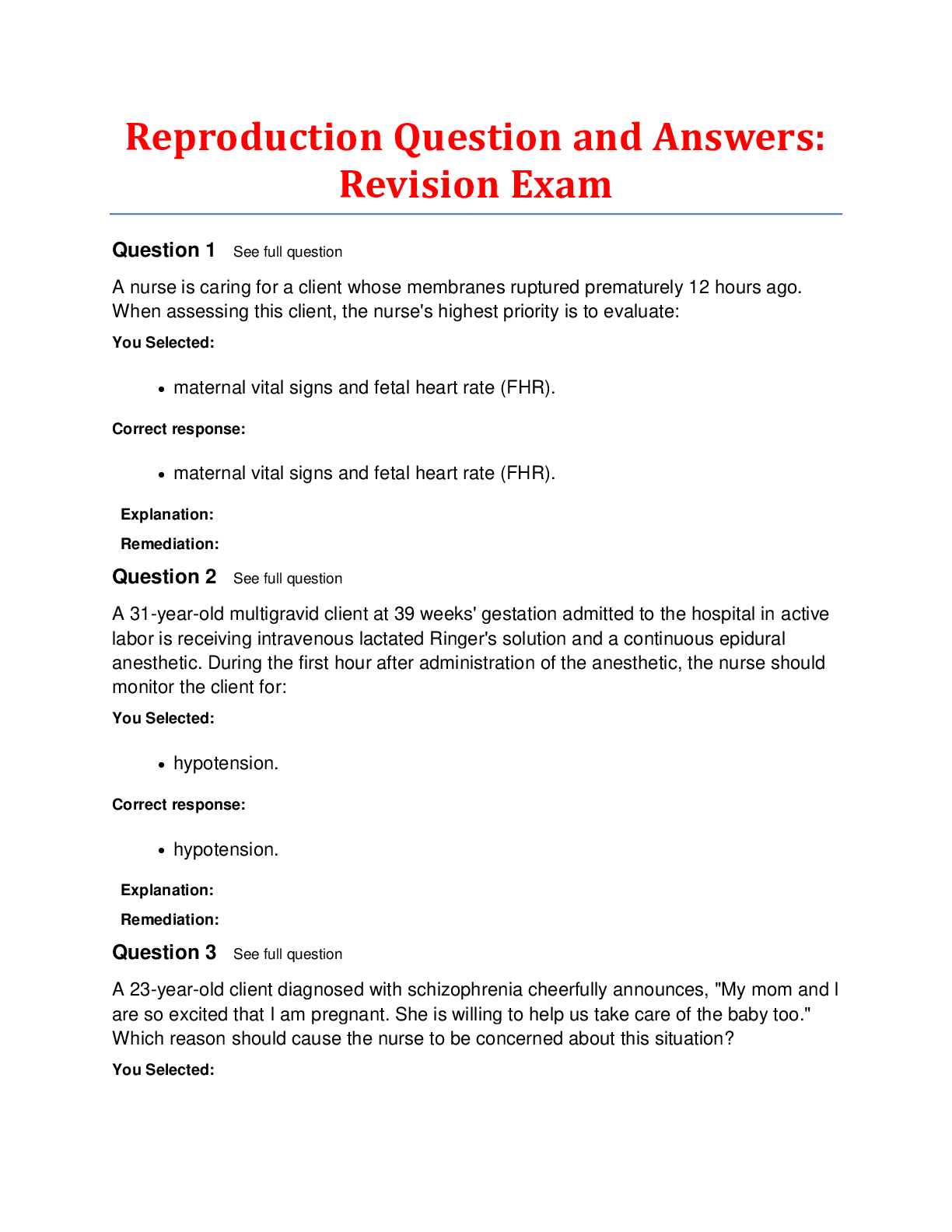
Buy this document to get the full access instantly
Instant Download Access after purchase
Add to cartInstant download
Reviews( 0 )
Document information
Connected school, study & course
About the document
Uploaded On
Aug 02, 2020
Number of pages
86
Written in
Additional information
This document has been written for:
Uploaded
Aug 02, 2020
Downloads
0
Views
249

